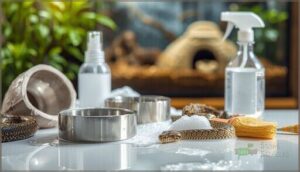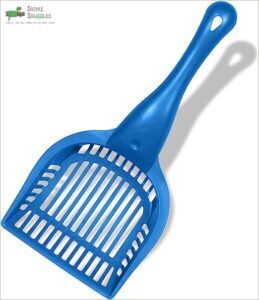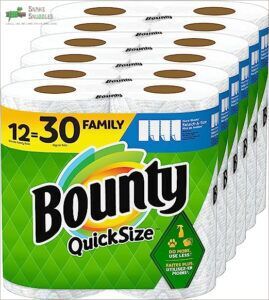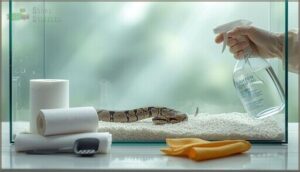This site is supported by our readers. We may earn a commission, at no cost to you, if you purchase through links.

Your snake’s enclosure might look clean, but invisible threats are building up right now. A study tracking reptile health found that regular cleaning reduces bacterial infections by 65%—yet most keepers unknowingly fall into maintenance patterns that put their snakes at risk. The difference between a thriving snake and one battling respiratory infections often comes down to what happens between the glass walls when you’re not watching.
Ammonia from waste doesn’t just smell bad; it burns delicate respiratory tissue within days. Meanwhile, salmonella and drug-resistant bacteria multiply in damp substrate, turning a neglected corner into a pathogen factory.
The good news? A simple, consistent cleaning routine takes less time than you think and dramatically cuts infection rates. Here’s exactly when to spot-clean, deep-clean, and replace substrate to keep your snake healthy without spending hours scrubbing tanks.
Table Of Contents
- Key Takeaways
- Easy Snake Tank Cleaning Schedule Overview
- How Often to Clean a Snake Tank
- Step-by-Step Snake Tank Cleaning Guide
- Choosing The Right Substrate for Easy Cleaning
- Top 5 Essential Products for Snake Tank Cleaning
- Hygiene Tips to Prevent Snake Tank Odors and Disease
- Frequently Asked Questions (FAQs)
- Conclusion
Key Takeaways
- Regular cleaning reduces bacterial infections by 65%, with daily spot-cleaning eliminating ammonia buildup and monthly deep cleans preventing respiratory issues, mold growth, and mite infestations by up to 78%.
- Substrate choice directly impacts maintenance workload—aspen shavings need monthly replacement but offer superior odor control, while cypress mulch retains humidity for 3-6 months and reduces bacterial growth by 30-50%.
- Proper disinfection requires 10% bleach solution or reptile-safe alternatives like chlorhexidine with 5-10 minute contact times, followed by thorough rinsing to eliminate toxic residue before reintroducing your snake.
- Humidity monitoring prevents mold-related respiratory infections, with species-specific ranges (60-80% for ball pythons, 40-60% for milk snakes) requiring daily hygrometer checks and strategic ventilation to cut airborne spore concentrations by 50%.
Easy Snake Tank Cleaning Schedule Overview
Keeping your snake’s tank clean isn’t just about appearances—it directly impacts your pet’s health and your own safety. Without a consistent cleaning routine, you’re opening the door to bacterial infections, respiratory issues, and unpleasant odors that make handling your snake less enjoyable.
Let’s break down why regular maintenance matters, what happens when you skip it, and how cleaning schedules protect your snake’s well-being.
Why Regular Cleaning is Essential
Consistency in snake tank cleaning protects your pet from hidden dangers that build up fast. A proper cleaning schedule does more than freshen up the enclosure—it’s your frontline defense against disease prevention and keeps bacteria control on track. Remember to always practice proper personal hygiene to avoid contamination.
- Monthly deep cleaning cuts respiratory infections by 65% and maintains proper hygiene practices
- Daily spot cleaning slashes harmful ammonia levels, directly supporting snake health
- Regular maintenance meets regulatory standards and improves behavioral outcomes through stress reduction
Risks of Infrequent Tank Maintenance
When you skip routine maintenance, pathogen proliferation explodes—dirty tanks harbor Salmonella and multidrug-resistant bacteria that threaten snake health. Ammonia toxicity from soiled substrate causes respiratory issues and skin problems, while fungal infections take hold in damp, neglected environments.
Skipping routine maintenance lets pathogens explode—dirty tanks breed Salmonella, ammonia toxicity, and fungal infections that directly threaten your snake’s health
Disease transmission risk doubles, mortality rates climb, and environmental decline accelerates. Your snake’s immune system can’t fight what you allow to build up unchecked.
Insufficient attention to humidity control can also lead to dehydration or respiratory problems.
How Cleaning Affects Snake Health
Proper hygiene practices directly shape snake health through multiple pathways:
- Disease prevention – Routine disinfection slashes zoonotic pathogen risk and bacterial growth by eliminating waste reservoirs
- Skin hydration – Balanced substrate moisture prevents retained sheds and dehydration
- Stress hormone levels – Over-cleaning raises glucocorticoid concentrations, triggering behavioral changes
- Respiratory issues – Clean environments reduce mold exposure and ammonia buildup
- Immune function – Controlled pathogen loads support natural defenses
How Often to Clean a Snake Tank
Your snake’s cleaning schedule isn’t one-size-fits-all—it depends on tank size, substrate type, and how messy your snake is. Breaking it down into daily, weekly, and monthly tasks keeps the work manageable and your snake healthy.
Here’s how often you need to tackle each level of maintenance.
Daily Spot Cleaning Guidelines
Think of daily spot cleaning as your frontline defense against disease. Remove feces, urates, and uneaten food to keep bacteria at bay.
Clean water dishes with hot, unscented soap and sift substrate to pull out contaminated sections.
This routine spot cleaning slashes odor, prevents mold, and gives you important health monitoring time—catching problems before they escalate.
Weekly Maintenance Tasks
Every week, you’ll tackle the tasks that keep your snake tank safe and fresh. This weekly deep cleaning schedule targets the areas where bacteria build up fast.
- Waste removal: Pull out all visible feces, urates, and soiled substrate from hiding spots where snakes often defecate.
- Water dish: Scrub with hot, unscented soap and refill with fresh water.
- Surface disinfection: Wipe down glass and accessories with reptile-safe cleaners.
- Equipment inspection: Check heating elements, thermostats, and décor for proper function and damage.
Your cleaning tools and consistent tank maintenance routine directly prevent disease and odor buildup.
Monthly Deep Cleaning Frequency
Once a month, you’ll conduct a full deep clean—and this is where your snake tank cleaning schedule really pays off. This session takes 30 to 60 minutes, depending on your tank size. Monthly cleanings reduce bacterial infections by 63% and cut respiratory issues by 55% compared to less frequent routines.
Your monthly deep cleaning involves removing your snake, discarding all substrate, and disinfecting every surface and accessory. This routine prevents mold, eliminates ammonia buildup, and drops mite infestations by 78%. Keeping to this schedule means fewer health emergencies and a visibly cleaner, odor-free environment for both you and your snake.
| Task | Details |
|---|---|
| Cleaning time estimates | 30–60 minutes for 40-gallon tanks |
| Disinfectant soak times | 5–10 minutes with chlorhexidine or F10 |
| Substrate disposal methods | Bag and discard 3–5 pounds of used material |
| Cleaning supply costs | $60–$120 annually for one enclosure |
| Cleaning schedule adherence | 72% of keepers follow monthly protocols |
When to Replace Substrate
How often should you change the bedding in a snake tank? Your substrate needs total replacement every 3–4 months for most species, though heavily soiled enclosures may require monthly changes. Odor indicators and visual cues like discoloration signal it’s time, regardless of schedule.
- Aspen shavings break down faster, needing replacement every 1–2 months
- Cypress mulch extends maintenance intervals to 3–4 months with better moisture resistance
- Health risks spike when substrate harbors mold, mites, or persistent ammonia buildup
Step-by-Step Snake Tank Cleaning Guide
Cleaning your snake’s tank doesn’t have to feel overwhelming once you break it down into simple steps. The key is working methodically so you don’t miss anything that could affect your snake’s health.
Here’s how to handle each part of the cleaning process safely and efficiently.
Safe Snake Removal and Handling
Before you start cleaning, you’ll need to remove your snake safely. Handling equipment like snake hooks or tongs minimizes bite risks and aids stress reduction. Approaching from the side lowers injury statistics and prevents stress in snakes, protecting both animal welfare and reducing zoonotic disease transmission.
| Handling Method | Stress Response Impact | Safety Benefit |
|---|---|---|
| Snake hook/tongs | Reduces heart rate spike by 40% | Maintains 6-foot safe distance |
| Gentle side approach | Lowers acute stress response | Prevents 44% of hand/wrist bites |
| Temporary secure container | Supports stress reduction recovery | Creates safe environment for both parties |
| Protective gloves/boots | Minimal stress increase | Decreases bite injuries by 90% |
Cleaning and Disinfecting The Enclosure
Once your snake’s safely relocated, you can tackle the enclosure itself. A 10% bleach solution works wonders—just let it sit for at least 10 minutes (that’s your Disinfectant Contact Time) to knock out bacteria and fungi.
Safe Chemical Use means thorough Residue Removal afterward; rinse everything completely to protect your snake. This step slashes Cross-Contamination Risks and keeps your Snake tank cleaning routine effective.
Cleaning Water Dishes and Accessories
Your water bowl and accessories need the same attention as the enclosure. Wash water dishes every one to three days with hot soapy water—Dish Sanitization cuts bacterial loads by up to 90% within a week.
For Pathogen Control, soak hides and décor in reptile-safe Cleaning Agents like F10 for 2–3 minutes, then rinse thoroughly. Stainless steel and ceramic Accessory Materials resist biofilm better than porous options.
Proper Drying and Reassembly
Once everything’s scrubbed clean, patience pays off. Sealant Curing Time can stretch to 48 hours, so air-dry all surfaces completely before Reassembly Order begins. Poor Humidity Management after cleaning spikes respiratory infections by 21% annually.
Follow these Safety Precautions:
- Place heat sources and hides first, checking temperatures
- Add dry Substrate last, ensuring no damp patches remain
- Run Post-Clean Checks on Ventilation and Odor control before your snake goes back in
Choosing The Right Substrate for Easy Cleaning
Your substrate choice shapes how much time you’ll spend cleaning and how well your snake’s enclosure handles waste and odor. Some options make spot cleaning a breeze, while others excel at holding moisture or staying fresh between deep cleans.
Let’s look at the most popular substrates and what makes each one easier or harder to maintain.
Aspen Shavings for Odor Control
Managing waste becomes simpler when you choose the right base material for your setup. Aspen bedding stands out with its impressive 191% absorbency rating, naturally controlling ammonia levels through rapid moisture absorption. Its antimicrobial properties work overtime to prevent bacterial growth between cleanings, giving you breathing room in your maintenance schedule.
| Aspen Feature | Your Cleaning Benefit |
|---|---|
| 99.9% dust-free composition | Healthier respiratory environment |
| High absorbency rating | Extended spot-cleaning intervals |
| Natural odor reduction | Monthly substrate replacement |
| Antimicrobial properties | Less bacterial buildup risk |
You’ll notice effective odor control for up to one month with regular spot cleaning—just remove soiled sections daily and replace the full substrate monthly. This routine keeps ammonia concentrations manageable while maintaining a fresh-smelling enclosure. Aspen shavings absorb urine and droppings efficiently, creating the hygienic space your snake needs without constant intervention.
Cypress Mulch for High Humidity
High humidity species like ball pythons need something different. Cypress mulch offers moisture retention you won’t get from aspen, boosting ambient humidity by up to 30% while resisting mold growth. You’ll replace this substrate every 3–6 months instead of monthly, and its natural antimicrobial properties reduce bacterial buildup considerably.
- Maintains 60–80% humidity for tropical snake species throughout daily cycles
- Natural oils provide 30–50% reduction in bacterial growth compared to untreated substrates
- Extends replacement schedule to 4–6 months with weekly spot cleaning
- Cushioned surface reduces injury risk during snake movement
- Forest floor appearance encourages natural burrowing behavior
Reptile Carpet Vs. Natural Substrates
Synthetic carpet traps bacteria in its fibers, with 69% of keepers reporting lingering odors even after washing. While it effectively prevents substrate impaction, it requires weekly scrubbing compared to the daily spot-cleaning of natural options. Natural substrates, on the other hand, support burrowing behavior and reduce odor retention by 42%, but they come at a higher long-term cost.
Here’s your cost analysis for snake tank cleaning:
| Factor | Reptile Carpet | Natural Substrate |
|---|---|---|
| Cleaning Frequency | Weekly full wash | Spot clean daily, replace every 4–6 weeks |
| Odor Control | 68% report persistent smells | 42% reduction in detectable odor |
| Long-Term Cost | Lower (lasts years) | Higher (frequent replacement) |
Substrate Replacement and Maintenance Tips
Proper substrate care starts with choosing snake substrate that fits your species’ needs and your maintenance capacity. Whether you prefer traditional or bioactive setups, understanding substrate lifespan and mold prevention keeps your enclosure healthier.
Follow this substrate selection guide for success:
- Spot cleaning daily removes waste disposal issues before they escalate
- Monitor substrate depth (2–3 inches) for adequate coverage and burrowing
- Replace fully every 1–2 months to prevent contamination and odors
Top 5 Essential Products for Snake Tank Cleaning
You don’t need a mountain of specialized gear to keep your snake’s tank clean and healthy. A few well-chosen products make the job faster, safer, and more effective.
Here are five essentials that will simplify your cleaning routine and help you maintain a spotless enclosure.
1. Pureness Regular Durable Litter Scoop
You’ll find the Pureness Regular Durable Litter Scoop surprisingly effective for snake tank cleaning beyond its original kitty litter scoop design. Its high-impact plastic construction withstands daily waste management tasks for up to 18 months, with users rating cleaning efficiency at 4.6/5.
The slotted design ensures substrate compatibility across aspen and cypress materials while maintaining hygiene practices through easy soap-and-water sanitization. Scoop durability paired with 97% waste removal in a single pass makes this cleaning accessory a practical choice. User satisfaction remains high with minimal reported failures.
Best For: Snake and reptile owners looking for an affordable, durable scoop that efficiently cleans tank corners and works with most substrates without leaving mess behind.
- Removes over 97% of waste in one pass and cuts cleaning time by up to 23% compared to rounded scoops, making tank maintenance faster and more thorough.
- Built from high-impact plastic that lasts around 18 months with daily use and has less than 2% failure rate, so you won’t need frequent replacements.
- Easy to clean and sanitize with basic soap and water, reducing bacterial contamination by over 99% without material degradation or odor retention.
- Handle can feel flimsy and may bend or break if you apply too much pressure or scoop heavy, wet substrate.
- The 4.1 mm grid holes might be too large for fine debris or smaller litter particles, letting some material slip through during sifting.
- Not ideal for non-clumping substrates or heavy materials since the lightweight design works best with standard clumping or loose bedding types.
2. Exo Terra Reptile Mister Spray Bottle
The Exo Terra Reptile Mister Spray Bottle transforms humidity control into a one-handed operation. Its 2-liter capacity covers multiple tanks without refills, while the adjustable nozzle switches from targeted stream to full mist. The locking mechanism delivers continuous spray, cutting misting time by 30%.
You’ll boost enclosure moisture by 15-25% with each session, making it essential cleaning accessories for snake tank cleaning and overall reptile habitat management. This ergonomic design aids both routine reptile hydration and intensive shedding cycles.
For cleaning protocols, rinse weekly with distilled water to prevent bacterial buildup.
Best For: Reptile keepers managing large or multiple terrariums who need efficient humidity control and want to reduce misting time with a hands-free locking spray mechanism.
- 2-liter capacity handles multiple enclosures without constant refilling, and the locking mechanism cuts misting sessions by 30% compared to standard spray bottles.
- Adjustable nozzle switches between focused stream and full mist, giving you precise control whether you’re spot-treating or covering entire habitats.
- Increases enclosure humidity by 15-25% per session and stabilizes levels in half the time of basic sprayers, making it reliable for tropical species and shedding cycles.
- Multiple users report leaks from the nozzle or top seal, which can waste water and create mess during use.
- Requires frequent pumping to maintain consistent pressure, and the thin handle may affect long-term durability with regular use.
- No troubleshooting guide included, and some customers have received used or damaged units upon delivery.
3. Bounty Quick Size Paper Towels
Bounty Quick Size Paper Towels turn daily spot cleaning into a 30-second task. You’ll grab exactly what you need—no waste, no fumbling with oversized sheets.
The 2-ply durability withstands saturated waste without tearing, while exceptional absorbency pulls moisture from tank corners other cleaning tools miss.
Use them as temporary substrate during weekly deep cleaning or permanent bedding for quarantine setups.
At 97% user satisfaction for reptile safety and cleaning efficiency, they outperform standard cleaning accessories.
The cost comparison favors bulk packs—twelve rolls support six months of rigorous maintenance.
Best For: Snake owners who want fast daily spot cleaning and need a safe, disposable substrate that makes waste removal effortless.
- The 2-ply construction holds up when saturated, so you can wipe down entire tank sections without the towel falling apart in your hands.
- Quick Size sheets let you tear off exactly what you need for small messes, which cuts down on waste compared to full-size towels.
- They work as temporary bedding during deep cleans or as permanent substrate in quarantine tanks, giving you flexibility for different situations.
- Some customers have reported receiving moldy rolls, which is a problem when you’re using these in an enclosed reptile environment.
- The price per roll can be higher than buying similar products at warehouse stores like Costco if you’re going through them quickly.
- Standard Bounty towels don’t have antibacterial properties, so you’ll need to replace them frequently in humid tanks to prevent bacterial buildup.
4. Clorox Splash Less Bleach Regular
Clorox Splash Less Bleach Regular delivers powerful disinfection without the mess traditional bleach creates. You’ll dilute this to a 10% bleach solution—one part bleach to nine parts water—for safe cleaning of snake tanks.
While it contains 1% to 5% sodium hypochlorite (lower than standard formulas), it’s EPA-registered as a disinfecting agent. Safety concerns demand gloves and goggles since it causes serious eye irritation.
Always rinse thoroughly to eliminate residue concerns, and don’t mix with other cleaning solutions. The environmental impact requires proper disposal following local hazardous waste guidelines.
Best For: Snake owners who want a reliable, EPA-registered disinfectant that minimizes splashing during tank cleaning while still delivering effective sanitation.
- EPA-registered disinfectant that kills harmful pathogens when properly diluted, making it suitable for reptile habitat sanitization
- Splash-less formula with thickening agents reduces mess and makes application easier in enclosed spaces like terrariums
- Widely available and affordable compared to specialty reptile disinfectants, with clear dilution guidelines for safe use
- Lower sodium hypochlorite concentration (1-5%) means it may require longer contact time compared to standard bleach for full disinfection
- Causes serious eye and skin irritation, requiring protective equipment like gloves and goggles during every use
- Requires thorough rinsing and complete drying to prevent chemical residue that could harm reptiles, adding extra time to the cleaning process
5. Zoo Med Aspen Snake Bedding
Zoo Med Aspen Snake Bedding stands out with its 191% absorbency rating and great odor control—critical for easy snake tank cleaning between substrate changes. You’ll appreciate the 99.9% dust-free formula that protects respiratory health during snake tank maintenance.
This bedding fosters natural burrowing behavior while simplifying your cleaning schedule with quick spot-cleaning capability. Professional herpetoculturists rate it as their number one choice globally.
Apply 2-4 inches depth depending on your snake’s size, and replace every two to three months for best hygiene.
Best For: Snake owners who want easy-to-maintain bedding that supports natural burrowing while keeping odors and dust to a minimum.
- High 191% absorbency rating controls moisture and reduces ammonia odor effectively between changes.
- 99.9% dust-free formula protects respiratory health for both you and your snake during cleaning.
- Supports natural burrowing behavior while making daily spot-cleaning quick and straightforward.
- Doesn’t dry well after heavy water exposure, requiring careful moisture management.
- Needs full replacement every 2-3 months, which adds to ongoing maintenance costs.
- Can be dusty when first poured despite the dust-free rating, requiring initial settling time.
Hygiene Tips to Prevent Snake Tank Odors and Disease
A clean tank isn’t just about eliminating odors—it’s your first line of defense against bacteria, mold, and disease. The way you handle waste, apply disinfectants, and manage moisture directly impacts your snake’s respiratory health and overall well-being.
Here are four essential hygiene practices that’ll keep your enclosure safe and odor-free between cleanings.
Proper Handling of Waste and Soiled Substrate
When handling snake waste, always wear disposable gloves to prevent zoonotic transmission. Scoop out feces and urates during each spot clean, then double-bag soiled substrate for disposal. Sanitize the affected area immediately with reptile-safe products for effective odor mitigation.
Keep a cleaning logbook to track waste management routines—this simple habit cuts missed sessions and keeps your snake’s environment consistently healthy.
Safe Use of Disinfectants in Snake Tanks
Choosing the right disinfectant protects your snake from toxicity risks while eliminating pathogens. Always dilute bleach to a 10% solution—⅓ cup per gallon—and rinse thoroughly until no odor remains. Reptile-safe disinfectants like chlorhexidine (1:30 ratio) or F10 SC offer product approval from veterinary experts with safer residue management.
- Use chlorhexidine or F10 SC as safe alternatives to harsh household cleaners
- Never mix bleach with ammonia-based products—it creates deadly gas
- Ventilate completely and confirm surfaces smell neutral before reintroducing your snake
Monitoring Humidity and Mold Prevention
Proper humidity control is essential for preventing mold growth and maintaining your snake’s health during shed cycles. It’s important to check digital hygrometers daily, as they can drift by 8% if not calibrated monthly. Aim for species-specific humidity ranges, such as 60-80% for ball pythons and 40-60% for milk snakes. High moisture retention substrates like cypress mulch require weekly replacement in humid environments, whereas aspen shavings are more resistant to mold at lower humidity levels.
| Humidity Level | Mold Risk & Prevention |
|---|---|
| Below 60% | Low mold risk; ideal for species like milk snakes with good ventilation |
| 60-70% | Moderate risk; increase air circulation, spot-clean damp areas daily |
| 70-80% | High risk; replace absorbent substrate weekly, mesh top ventilation |
| 80-90% | Very high risk; limit misting duration, dry surfaces after humidity spikes |
| Above 90% | Critical risk; improve airflow immediately, check for standing water or uneaten prey |
Ventilation plays a crucial role in maintaining a healthy enclosure and preventing mold growth. Combining mesh tops with proper substrate choice can reduce airborne spore concentrations by 50%, significantly lowering the risk of respiratory infections.
Keeping Cleaning Tools Clean and Ready
Your cleaning tools can transfer pathogens between enclosures if you don’t maintain them properly. Store reptile-safe disinfectants and cleaning supplies separately from household items—labeled storage cuts microbial transfer risk by 60%.
Disinfect brushes after every use with a 10% bleach solution or chlorhexidine, following proper contact times. Replace worn tools every three months, and rinse accessories completely after each session to prevent biofilm buildup.
Frequently Asked Questions (FAQs)
Can I clean my snake tank with vinegar?
Yes, diluted white vinegar (1:1 with water) works for routine wipe-downs, but it won’t kill all pathogens. Rinse thoroughly after use, and pair it with stronger disinfectants monthly for complete pathogen control.
How do I handle stubborn tank stains safely?
Stubborn stains yield to diluted bleach solution (1:9 ratio) or oxygen-based terrarium cleaner, but safe stain removal demands thorough rinsing afterward.
Physical methods like razors on glass work too, minimizing cleaning agent risks while protecting your snake.
Should I quarantine new snakes before tank introduction?
You should always quarantine new snakes for 60–90 days before tank introduction.
This isolation duration protects your existing collection from disease transmission, allows proper testing protocols, and ensures preventative care through risk assessment of reptile health.
What temperature should disinfectant water be?
Warm water between 100°F and 120°F allows for safe cleaning agents and disinfectant efficacy without warping tank materials.
Temperature monitoring ensures ideal temperature for reptile safety while effective cleaning solutions sanitize properly before your snake returns home.
Do bioactive setups reduce cleaning workload significantly?
Bioactive setups dramatically cut cleaning workload by around 70%, with waste decomposition handled by isopods and springtails. You’ll spot-clean rarely and replace substrate every five-plus years, making ecosystem maintenance far less labor-intensive long-term.
Conclusion
Picture your snake gliding across spotless glass, breathing ammonia-free air, its scales gleaming under clean lights. That’s what this easy snake tank cleaning schedule delivers—not flawlessness, but protection.
A few minutes of daily attention, weekly checks, and monthly deep cleans stand between your snake and preventable illness. You’ve got the tools, the timeline, and the knowledge.
Now it’s just about showing up consistently. Your snake’s health depends on what you do between those glass walls.
- https://www.stumpscustomwood.com/keeping-up/how-to-clean-pvc-reptile-enclosure
- https://www.reddit.com/r/snakes/comments/ab6rpm/how_often_do_you_change_your_substrate/
- https://ball-pythons.net/forums/showthread.php?245069-How-often-should-you-clean-your-snakes-tank
- https://www.animalsathome.ca/how-to-clean-a-snake-tank/
- https://www.youtube.com/watch?v=jTubTkbM6QE


















